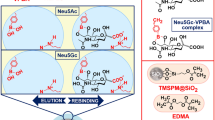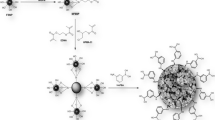Abstract
A boronate affinity monolith with improved affinity and selectivity for glycoproteins was prepared starting from two monomers. The first is 3-aminopropyltriethoxysilane-methacrylic acid (APTES-MAA), and the other is a polyhedral oligomeric silsesquioxane (POSS) monomer. In the next step, 3-(acrylamido)benzeneboronic acid was adopted as boronate affinity ligand, and ethylene glycol dimethacrylate as the crosslinker, and iso-propanol and octanol as binary porogens. The synergistic effect of APTES-MAA and POSS warrants good affinity and selectivity for glycoproteins, which results in a number of attractive features including (a) a wide operation pH range (from 5 to 8); (b) higher enrichment factors ranging from 19.3 to 20.6; (c) greater recoveries of glycoproteins between 95.8 and 107.1%; (d) lower relative standard deviations of ≤4.2%. Compared to the corresponding APTES-MAA/POSS-free monolith, the new boronate material had 1.7-fold increased glycoprotein recovery from complex samples. Glycoproteins in 500-fold diluted serum samples can be enriched by the boronate monolith.

Schematic representation of the preparation of 3-aminopropyltriethoxysilane-methacrylic acid/polyhedral oligomeric silsesquioxanes boronate affinity monolith. This sorbent exhibits high selectivity and wide pH operation range for capturing glycopeptides.





Similar content being viewed by others
References
Sun X, Jian Y, Wang H, Ge S, Yan M, Yu J (2019) Ultrasensitive microfluidic paper-based electrochemical biosensor based on molecularly imprinted film and boronate affinity sandwich assay for glycoprotein detection. ACS Appl Mater Interfaces 11:16198–16206
Chang L, Wu H, He X, Chen L, Zhang Y (2017) A highly sensitive fluorescent turn-on biosensor for glycoproteins based on boronic acid functional polymer capped Mn-doped ZnS quantum dots. Anal Chim Acta 995:91–98
Tian Y, Zhang H (2013) Characterization of disease-associated N-linked glycoproteins. Proteomics 13:504–511
Alley WR Jr, Mann BF, Novotny MV (2013) High-sensitivity analytical approaches for the structural characterization of glycoproteins. Chem Rev 113:2668–2732
Li D, Chen Y, Liu Z (2015) Boronate affinity materials for separation and molecular recognition: structure, properties and applications. Chem Soc Rev 44:8097–8123
Sun XY, Ma RT, Chen J, Shi YP (2017) Boronate-affinity based magnetic molecularly imprinted nanoparticles for the efficient extraction of the model glycoprotein horseradish peroxidase. Microchim Acta 184(10):3729–3737
Nauom S, da Silva Neto BR, Ribeiro MS, Pedersoli WR, Ulhoa CJ, Silva RN, Monteiro VN (2019) Biochemical and molecular study of trichoderma harzianum enriched secretome protein profiles using lectin affinity chromatography. Appl Biochem Biotechnol 187:1–13
Zhang Y, Kuang M, Zhang L, Yang P, Lu H (2013) An accessible protocol for solid-phase extraction of N-linked glycopeptides through reductive amination by amine-functionalized magnetic nanoparticles. Anal Chem 85:5535–5541
Mayang YC, He XW, Chen LX, Zhang YK (2017) Detection of transferrin by using a surface plasmon resonance sensor functionalized with a boronic acid monolayer. Microchim Acta 184:2749–2757
Zhou C, Chen X, Du Z, Li G, **ao X, Cai Z (2017) A hybrid monolithic column based on boronate-functionalized graphene oxide nanosheets for online specific enrichment of glycoproteins. J Chromatogr A 1498:90–98
Zhou XJ, Mo CE, Chen M, Huang YP, Liu ZS (2018) Improving affinity of boronate capillary monolithic column for microextraction of glycoproteins with hydrophilic macromonomer. J Chromatogr A 1581-1582:8–15
Sun XY, Ma RT, Chen J, Shi YP (2018) Magnetic boronate modified molecularly imprinted polymers on magnetite microspheres modified with porous TiO2 (Fe3O4@pTiO2@MIP) with enhanced adsorption capacity for glycoproteins and with wide operational pH range. Microchim Acta 185(12):565
Ren L, Liu Z, Liu Y, Dou P, Chen HY (2009) Ring-opening polymerization with synergistic co-monomers: access to a boronate-functionalized polymeric monolith for the specific capture of cis-diol-containing biomolecules under neutral conditions. Angew Chem Int Ed 48:6704–6707
Ren L, Liu Z (2011) A self-assembled molecular team of boronic acids at the gold surface for specific capture of cis-diol biomolecules at neutral pH. Chem Commun 47:2255–2257
Liu Y, Ren L, Liu Z (2011) A unique boronic acid functionalized monolithic capillary for specific capture, separation and immobilization of cis-diol biomolecules. Chem Commun 47:5067–5069
Yang Q, Huang D, ** S, Zhou H, Zhou P (2013) One-step synthesis of an organic-inorganic hybrid boronate affinity monolithic column with synergistic co-monomers. Analyst 138:4752–4755
Li H, Wang H, Liu Y, Liu Z (2012) A benzoboroxole-functionalized monolithic column for the selective enrichment and separation of cis-diol containing biomolecules. Chem Commun 48:4115–4117
Li D, Li Q, Wang S, Ye J, Nie H, Liu Z (2014) Pyridinylboronic acid-functionalized organic-silica hybrid monolithic capillary for the selective enrichment and separation of cis-diol-containing biomolecules at acidic pH. J Chromatogr A 1339:103–109
Liu Y, Lu Y, Liu Z (2012) Restricted access boronate affinity porous monolith as a protein a mimetic for the specific capture of immunoglobulin G. Chem Sci 3:1467–1471
Dremina ES, Li X, Galeva NA, Sharov VS, Stobaugh JF, Schöneich C (2011) A methodology for simultaneous fluorogenic derivatization and boronate affinity enrichment of 3-nitrotyrosine-containing peptides. Anal Biochem 418:184–196
Matsumoto A, Yoshida R, Kataoka K (2004) Glucose-responsive polymer gel bearing phenylborate derivative as a glucose-sensing moiety operating at the physiological pH. Biomacromolecules 5:1038–1045
Wulff G (1982) Selective binding to polymers via covalent bonds. The construction of chiral cavities as specific receptor sites. Pure Appl Chem 54:2093–2102
Alves F, Nischang I (2015) Radical-mediated step-growth: preparation of hybrid polymer monolithic columns with fine control of nanostructural and chromatographic characteristics. J Chromatogr A 1412:112–125
Tang W, Li G, Row KH, Zhu T (2016) Preparation of hybrid molecularly imprinted polymer with double-templates for rapid simultaneous purification of theophylline and chlorogenic acid in green tea. Talanta 152:1–8
Chen Y, Chen M, Chi J, Yu X, Chen Y, Lin X, **e Z (2018) Aptamer-based polyhedral oligomeric silsesquioxane (POSS)-containing hybrid affinity monolith prepared via a "one-pot" process for selective extraction of ochratoxin A. J Chromatogr A 1563:37–46
Bagheri H, Soofi G, Javanmardi H, Karimi M (2018) A 3D nanoscale polyhedral oligomeric silsesquioxanes network for microextraction of polycyclic aromatic hydrocarbons. Mikrochim Acta 185:418
Wang X, Yang FF, Zhang LP, Huang YP, Liu ZS (2018) A polyhedral oligomeric silsesquioxane/molecular sieve codoped molecularly imprinted polymer for gastroretentive drug-controlled release in vivo. Biomater Sci 6:3170–3177
Zhang Y, Zhuang Y, Shen H, Chen X, Wang J (2017) A super hydrophilic silsesquioxane-based composite for highly selective adsorption of glycoproteins. Microchim Acta 184(4):1037–1044
Kruger NJ (1994) The Bradford method for protein quantitation. Methods Mol Biol 32:9–15
Sing KSW (1982) Reporting physisorption data for gas/solid systems with special reference to the detemination of surface area and porosity. Pure Appl Chem 54:2201–2218
Liu C, Deng Q, Fang G, Huang X, Wang S (2014) Facile synthesis of graphene doped poly(ionic liquid) boronate affinity material for specific capture of glycoproteins. J Mater Chem B 2:5229–5237
Yang F, Mao J, He XW, Chen LX, Zhang YK (2013) Synthesis of boronate-silica hybrid affinity monolith via a one-pot process for specific capture of glycoproteins at neutral conditions. Anal Bioanal Chem 405:6639–6648
** S, Liu L, Zhou P (2018) Amorphous titania modified with boric acid for selective capture of glycoproteins. Microchim Acta 185(6):308
Wu Q, Jiang B, Weng Y, Liu J, Li S, Hu Y, Yang K, Liang Z, Zhang L, Zhang Y (2018) 3-Carboxybenzoboroxole functionalized polyethylenimine modified magnetic graphene oxide nanocomposites for human plasma glycoproteins enrichment under physiological condition. Anal Chem 90:2671–2677
Acknowledgments
This work was supported by National Natural Science Foundation of China (Grant No. 21775109).
Author information
Authors and Affiliations
Corresponding authors
Additional information
Publisher’s note
Springer Nature remains neutral with regard to jurisdictional claims in published maps and institutional affiliations.
Electronic supplementary material
ESM 1
(DOCX 1070 kb)
Rights and permissions
About this article
Cite this article
Shen, YF., Yuan, FF., Liu, XY. et al. Synergistic effect of organic-inorganic hybrid monomer and polyhedral oligomeric silsesquioxanes in a boronate affinity monolithic capillary/chip for enrichment of glycoproteins. Microchim Acta 186, 812 (2019). https://doi.org/10.1007/s00604-019-3938-z
Received:
Accepted:
Published:
DOI: https://doi.org/10.1007/s00604-019-3938-z




